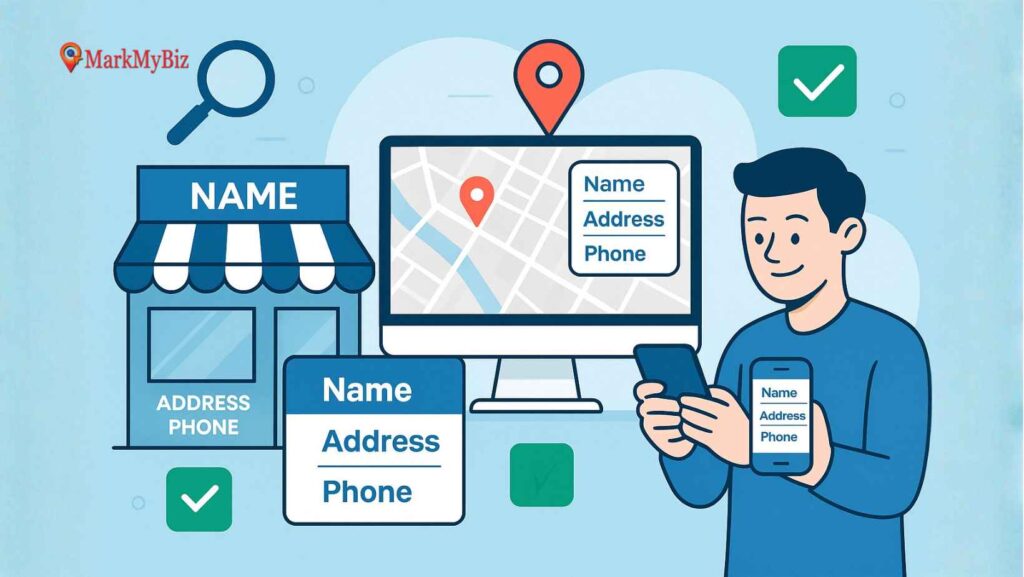Local SEO isn’t just about keywords and backlinks—it’s also about accuracy and trust. Two elements that directly influence your local visibility are NAP consistency (Name, Address, Phone number) and User Experience (UX). Together, they create the foundation of how search engines evaluate your business and how customers interact with it.
In this article, we’ll break down why NAP consistency and UX matter, how they shape the user journey, and what steps you can take to optimize them.
1. What Is NAP and Why Does It Matter?
NAP refers to your business Name, Address, and Phone number. These details are used by Google and other search engines to confirm your business’s identity and decide if you’re trustworthy enough to appear in the Local Pack or map listings.
A consistent NAP across your website, Google Business Profile, directories, and social platforms reduces errors, builds credibility, and helps your listings surface for the right queries.
But NAP isn’t just for algorithms—humans rely on it too. A wrong phone number, outdated address, or inconsistent store hours can frustrate potential customers and send them to competitors.
2. The User Journey Starts Earlier Than You Think
Many business owners assume that the customer journey begins when a person calls, emails, or lands on their website. In reality, the journey often starts much sooner—sometimes with a simple search query or map lookup.
According to Google data, most purchases are influenced by five touchpoints:
- Using a search engine
- Visiting a physical location
- Exploring a retailer’s website or app
- Visiting another website or app
- Using a map application
Your business information must be consistent across all these touchpoints. A seamless experience at this early stage increases the likelihood that a searcher will continue down the path to becoming a customer.
3. NAP Consistency and Local Pack Rankings
The Local Pack—those three map results shown in Google Search—is heavily influenced by both location and business data accuracy. If Google detects conflicting versions of your NAP, its trust in your listing drops.
For example, if your store hours differ between Yelp, Facebook, and Google Business Profile, which one should Google believe? This uncertainty can cause your business to rank lower or, worse, not appear at all.
Maintaining a consistent NAP reassures search engines that your business is reliable, which improves your chances of appearing in top results.
4. The Problem with Lazy Local Pages
Many businesses try to localize their SEO strategy by creating “local pages.” While this can work, poorly executed pages—also known as doorway pages—offer little value to users.
Doorway pages are thin, repetitive, and designed only to rank for city-specific keywords. Google rolled out updates like the Doorway Page Algorithm (2015) and Possum (2016) to minimize their visibility.
Instead of doorway content, businesses should focus on creating value-driven local pages that:
- Highlight genuine services in the location
- Provide unique insights, guides, or resources
- Use supporting content (blogs, FAQs, tips) to add topical relevance
This not only helps rankings but also delivers a better experience for local searchers.
5. Common Causes of NAP Inconsistency
NAP issues often arise from simple oversights, such as:
- Moving to a new address without updating all listings
- Using different store vs. registered office addresses online
- Generating multiple phone numbers for call tracking purposes
- Human error during directory submissions
While attribution tracking is useful, publishing inconsistent NAP details can create long-term SEO problems and confuse users.
6. Google Business Profile & Attribution Challenges
Google Business Profile (GBP) is central to local SEO, but it also has attribution issues. Traffic from GBP listings often appears as direct traffic in Google Analytics instead of organic, making it difficult to measure ROI.
The solution? Add UTM parameters to your GBP links, such as:
?utm_source=GMBlisting&utm_medium=organicThis won’t affect NAP consistency but will give you more accurate reporting.
7. Directory Listings and Duplicate Issues
Some directories automatically create GBP listings from the data you provide. If you use different phone numbers for attribution, this can result in duplicate GBP listings with mismatched details—hurting both SEO and user experience.
To fix this, request Google to merge duplicate profiles or mark them as “duplicates.” Ensuring there’s only one correct listing per location strengthens your local presence.
8. Best Practices for Maintaining NAP Accuracy
Here’s how to keep your NAP clean and consistent:
- Audit regularly – Check all citations and correct mismatches.
- Standardize your format – Use the same name style, address abbreviations, and phone format everywhere.
- Leverage tools – Use platforms like Moz Local, BrightLocal, or Yext to manage listings at scale.
- Implement schema markup – Add LocalBusiness schema on your website to reinforce NAP details for search engines.
- Update promptly – Any time you change locations, phone numbers, or hours, update them across all platforms immediately.
9. The Bigger Picture: UX + SEO
Ultimately, NAP consistency isn’t just about search rankings—it’s about people. A customer who encounters outdated information will likely lose trust and turn to competitors.
By combining accurate NAP with a frictionless user journey (fast website, mobile optimization, clear CTAs), you not only boost SEO performance but also win customer confidence.
Final Thoughts
Local SEO success depends on more than keywords and backlinks. Consistency and user experience are what truly set businesses apart.
- A consistent NAP builds Google’s trust and ensures customers can find you easily.
- A seamless user journey keeps people engaged and more likely to convert.
Together, they create a powerful foundation for visibility, credibility, and long-term local growth.










